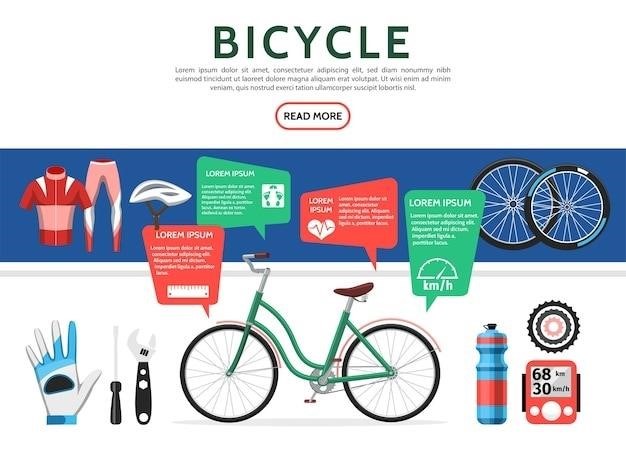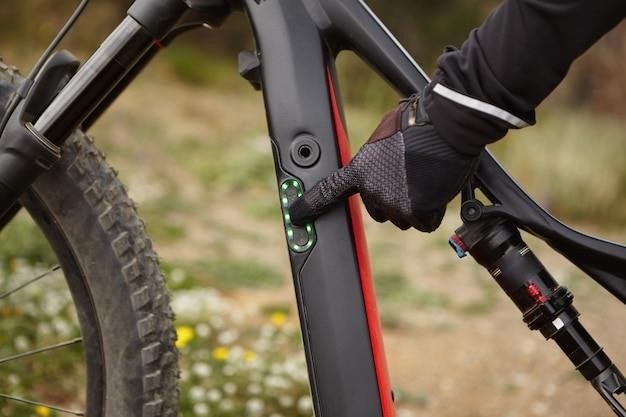Understanding Mountain Bike Frame Sizes
Choosing the right mountain bike frame size is crucial for comfort and control. Traditional sizing relied on seat tube length‚ but modern methods prioritize reach and effective top tube. Consider your height‚ inseam‚ and riding style for optimal fit.
Traditional Sizing Methods
Historically‚ mountain bike frame sizes were determined primarily by the length of the seat tube‚ measured from the center of the bottom bracket to the top of the seat tube. This method‚ while simple‚ often overlooked other crucial dimensions affecting rider fit and comfort. Stand-over height‚ the distance between the top tube and the ground when the bike is upright‚ was another key consideration‚ ensuring sufficient clearance for the rider’s legs. However‚ this approach lacked precision‚ failing to account for variations in torso length and arm reach among individuals of the same height. Manufacturers often used a combination of seat tube length and stand-over height‚ resulting in inconsistencies across brands and models. This older system often led to less-than-ideal fits for many riders. The limitations of this system paved the way for more refined sizing approaches in the modern era.
Modern Sizing Systems⁚ Reach and Effective Top Tube
Contemporary mountain bike sizing emphasizes reach and effective top tube length for a more accurate and rider-centric fit. Reach measures the horizontal distance from the bottom bracket to the center of the head tube‚ a crucial factor determining rider position and overall feel. A longer reach generally results in a more stretched-out riding posture‚ while a shorter reach offers a more compact and upright position. Effective top tube length‚ a related measurement‚ considers the slope of the top tube‚ providing a more accurate representation of the horizontal distance between the saddle and handlebars. These measurements‚ along with other geometrical data like head tube angle and wheelbase‚ are now commonly found in detailed geometry charts provided by manufacturers. This detailed approach offers a more precise way to select a bike tailored to individual rider preferences and body proportions. Combining these modern metrics with traditional considerations like height and inseam provides a comprehensive approach to mountain bike frame selection.

Using a Mountain Bike Size Chart
Mountain bike size charts use height and inseam to suggest a frame size. However‚ brand-specific charts should always be consulted due to variations in geometry and design.
Height-Based Size Charts
Many mountain bike size charts utilize height as the primary determinant for frame size. These charts typically present a range of heights corresponding to specific frame sizes (e.g.‚ small‚ medium‚ large‚ extra-large). While convenient‚ height-based charts offer a simplified approach and may not account for individual variations in torso length‚ leg length‚ or riding style. Riders with proportionally longer legs or torsos might find a height-based chart inaccurate. For instance‚ a taller rider with shorter legs might be more comfortable on a smaller frame than suggested by a purely height-based chart‚ while a rider with longer legs and a shorter torso might need a larger frame. Always consider the limitations of these charts and use them as a starting point rather than a definitive guide.
Inseam-Based Size Charts
Inseam-based mountain bike size charts offer a more refined approach compared to height-based charts‚ focusing on the length of your inner leg. Measuring your inseam provides a more precise indication of your lower body proportions‚ which significantly impact bike fit and comfort; These charts correlate inseam measurements with recommended frame sizes‚ providing a more tailored suggestion than height alone. However‚ inseam-based charts still don’t account for torso length variations. A rider with a long torso and a shorter inseam might need a different frame size than a rider with a short torso and the same inseam. Inseam measurement‚ therefore‚ serves as a valuable additional factor alongside height when assessing appropriate frame size‚ offering a more accurate prediction than relying solely on height.
Considering Brand-Specific Charts
While general size charts offer a helpful starting point‚ it’s crucial to consult the manufacturer’s specific size chart for the particular mountain bike model you’re considering. Frame geometry varies considerably across brands‚ even among bikes with the same size designation. A “medium” from one brand may have a significantly different reach‚ effective top tube length‚ and stack height compared to a “medium” from another. Ignoring brand-specific charts can lead to an ill-fitting bike‚ impacting comfort‚ control‚ and overall riding experience. Always prioritize the manufacturer’s data to ensure accurate sizing and to avoid potential compatibility issues. These detailed charts often include additional specifications relevant to frame geometry‚ offering a more precise fit assessment. Relying solely on generic size guides can result in a less-than-ideal fit; always check the manufacturer’s recommendations.
Factors Beyond Height and Inseam
Riding style significantly influences frame size choice. Body proportions and preferred wheel size (26″‚ 27.5″‚ 29″) also play a crucial role in finding the perfect fit.
Riding Style and Body Proportions
Your riding style significantly impacts the ideal mountain bike frame size. Aggressive riders who frequently stand while pedaling might prefer a slightly larger frame for stability and maneuverability‚ especially on descents. Conversely‚ those who prioritize agility and quick turns might find a smaller frame more suitable. Consider your torso length relative to your leg length. Riders with longer torsos might benefit from a frame with a longer reach for a more comfortable riding position‚ while those with shorter torsos might find a shorter reach more manageable. Ultimately‚ the perfect fit balances comfort and control tailored to your individual preferences and physical attributes. Don’t hesitate to consult a professional bike fitter for personalized guidance.
Wheel Size Considerations (26″‚ 27.5″‚ 29″)
Wheel size significantly influences a mountain bike’s handling and performance‚ indirectly affecting the perceived frame size. 26-inch wheels‚ once the standard‚ offer exceptional maneuverability in tight spaces but can feel less stable at higher speeds. 27.5-inch (650b) wheels provide a balance between agility and stability‚ making them a popular choice for many riders. 29-inch wheels excel in rolling over obstacles and maintaining momentum‚ especially on rough terrain. However‚ they can feel less nimble than smaller wheels. The best wheel size depends on your riding style and terrain. Consider the type of trails you frequent and your preferences for speed versus maneuverability. Keep in mind that frame geometry often varies between wheel sizes‚ even within the same model‚ further impacting the overall fit and feel.
Advanced Geometry Considerations
Beyond basic sizing‚ consider reach‚ wheelbase‚ and head tube angle. These impact handling‚ stability‚ and overall riding experience. Longer reach generally means more stability; shorter reach offers increased agility.
Reach⁚ The Key Measurement
Reach is a critical measurement in modern mountain bike sizing‚ representing the horizontal distance from the bottom bracket to the center of the head tube; Unlike older sizing methods that focused on seat tube length‚ reach directly affects rider position and handling. A longer reach results in a more stretched-out riding posture‚ promoting stability at higher speeds and on rough terrain. This is often preferred by aggressive riders or those who prioritize downhill performance. Conversely‚ a shorter reach places the rider in a more compact and upright position‚ enhancing maneuverability and agility‚ particularly beneficial for technical trails and tighter spaces. Many riders find a slightly longer reach improves comfort on longer rides. The ideal reach will depend on personal preferences and riding style‚ making it crucial to compare reach measurements across different frame sizes and brands when choosing a mountain bike.
Wheelbase and Stability
The wheelbase‚ the distance between the centers of the front and rear wheels‚ significantly impacts a mountain bike’s stability and handling characteristics. A longer wheelbase generally provides increased stability at higher speeds and on rough terrain‚ making it easier to maintain control on steep descents or challenging sections. This is because a longer wheelbase increases the bike’s moment of inertia‚ making it less susceptible to quick changes in direction. However‚ a longer wheelbase can make the bike feel less agile and more difficult to maneuver in tight‚ technical sections or on switchbacks. Conversely‚ a shorter wheelbase enhances maneuverability and agility‚ allowing for quicker changes in direction and easier handling in confined spaces. The optimal wheelbase length depends on the intended riding style and terrain. Aggressive riders who prioritize downhill performance might prefer a longer wheelbase for stability‚ while those who focus on technical trails and tight turns might prefer a shorter wheelbase for agility.
Finding the Right Fit
Fine-tuning your mountain bike’s fit is key. Adjust saddle height and handlebar position for optimal comfort and control. Test ride different sizes to find the perfect match for your body and riding style.
Adjusting Saddle Height and Handlebar Position
Once you’ve selected a frame size‚ fine-tuning the saddle height and handlebar position is crucial for optimal comfort and performance. Proper saddle height ensures efficient pedaling and reduces strain on your knees. Too high‚ and you’ll feel stretched and uncomfortable; too low‚ and your knees will likely hyperextend. Experiment to find the “sweet spot” where you can comfortably reach the pedals while maintaining a slight bend in your knee.
Handlebar position significantly impacts your riding posture and control. A higher handlebar position provides a more upright‚ comfortable posture suitable for longer rides and less aggressive terrain. Conversely‚ a lower position offers a more aerodynamic and aggressive stance ideal for speed and technical descents. Consider your riding style and adjust accordingly. Many bikes offer stem adjustments that allow for quick changes in handlebar height. Don’t hesitate to experiment and make small adjustments to find what suits you best.
Test Riding Different Sizes
While size charts offer a helpful starting point‚ the best way to determine the ideal mountain bike frame size is through test riding. Visit a local bike shop and request to test ride bikes within a size range that seems appropriate based on your measurements and riding style. Pay close attention to how each bike feels. A bike that’s too small might feel cramped and restrict your movement‚ while a bike that’s too large can feel unwieldy and difficult to control‚ especially on technical terrain.
During your test ride‚ focus on comfort and maneuverability. Consider how easily you can reach the handlebars and pedals‚ and how comfortable your posture is. Ride over various terrains—smooth pavement‚ rough trails‚ and climbs—to evaluate the bike’s handling and stability. Don’t rush the process; take your time to assess each bike thoroughly before making a decision. Remember‚ finding the right fit is a process that requires careful consideration and experimentation.

Special Considerations
Women’s and youth mountain bikes often require different sizing approaches due to unique body proportions and riding styles. Proper fit is paramount for comfort and performance.
Women’s Specific Mountain Bikes
While women can utilize standard mountain bike size charts‚ women-specific models often incorporate design features to enhance comfort and performance. These bikes typically feature shorter top tubes‚ adjusted stand-over heights‚ and components optimized for a woman’s anatomy. The geometry is tailored to account for differences in average torso length‚ arm length‚ and overall body proportions. Manufacturers often offer different color options and component choices for women’s models‚ aiming for a more appealing aesthetic. Ultimately‚ the best fit depends on individual body measurements and riding preferences‚ regardless of whether the bike is specifically designed for women.
Youth Mountain Bikes
Sizing youth mountain bikes differs significantly from adult models. Instead of focusing on frame size in inches or using standard size designations (S‚ M‚ L‚ XL)‚ youth bikes are primarily sized by wheel diameter. Common sizes include 20-inch‚ 24-inch‚ and 26-inch wheels‚ each corresponding to a different age and height range. A child’s height and inseam are key factors‚ but manufacturers provide detailed size charts that relate wheel size to rider dimensions. Proper fit is crucial for a young rider’s comfort‚ safety‚ and skill development. Too large a bike can be overwhelming and dangerous‚ while one that’s too small can be uncomfortable and limit the child’s ability to control the bike effectively. Always consult the manufacturer’s size chart for your child’s specific needs.
